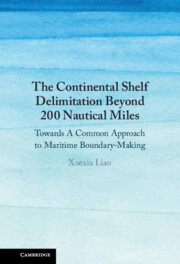 The Continental Shelf Delimitation Beyond 200 Nautical Miles
The Continental Shelf Delimitation Beyond 200 Nautical Miles Book contents
- The Continental Shelf Delimitation Beyond 200 Nautical Miles
- The Continental Shelf Delimitation Beyond 200 Nautical Miles
- Copyright page
- Contents
- Figures
- Table of Cases
- Table of Treaties
- Foreword
- Preface
- Abbreviations
- 1 Legal Uncertainties in the Continental Shelf Delimitation beyond 200 NM
- Part I Overlapping Entitlements to the Continental Shelf beyond 200 Nautical Miles
- 2 Establishing the Entitlement to the Continental Shelf beyond 200 NM
- 3 Defining Overlapping Entitlements to the Continental Shelf beyond 200 NM
- 4 Interaction between Delineation and Delimitation of the Continental Shelf beyond 200 NM
- Part II Delimitation Methodology for the Continental Shelf beyond 200 Nautical Miles
- Book part
- Bibliography
- Index
2 - Establishing the Entitlement to the Continental Shelf beyond 200 NM
from Part I - Overlapping Entitlements to the Continental Shelf beyond 200 Nautical Miles
Published online by Cambridge University Press: 08 October 2021
- The Continental Shelf Delimitation Beyond 200 Nautical Miles
- The Continental Shelf Delimitation Beyond 200 Nautical Miles
- Copyright page
- Contents
- Figures
- Table of Cases
- Table of Treaties
- Foreword
- Preface
- Abbreviations
- 1 Legal Uncertainties in the Continental Shelf Delimitation beyond 200 NM
- Part I Overlapping Entitlements to the Continental Shelf beyond 200 Nautical Miles
- 2 Establishing the Entitlement to the Continental Shelf beyond 200 NM
- 3 Defining Overlapping Entitlements to the Continental Shelf beyond 200 NM
- 4 Interaction between Delineation and Delimitation of the Continental Shelf beyond 200 NM
- Part II Delimitation Methodology for the Continental Shelf beyond 200 Nautical Miles
- Book part
- Bibliography
- Index
Summary
This chapter discusses in detail the establishment of the entitlement to the continental shelf beyond 200 nautical miles under the United Nations Convention on the Law of the Sea. The meaning of natural prolongation, which is historically significant yet nebulous, has been transformed by Article 76, and its interpretation has to be examined in the context of application of Article 76 by coastal States and the Commission on the Limits of the Continental Shelf. The Bangladesh/Myanmar case clarified the meaning of natural prolongation, but its reasoning fell short of giving the notion any effect as a treaty term. In addition, other elements constitutive of the entitlement to the continental shelf beyond 200 nm, including the foot of the continental slope, the outer limits of the continental shelf, and the coasts are analyzed and their role in the process clarified.
Keywords
- Type
- Chapter
- Information
- The Continental Shelf Delimitation Beyond 200 Nautical MilesTowards A Common Approach to Maritime Boundary-Making, pp. 15 - 50Publisher: Cambridge University PressPrint publication year: 2021


